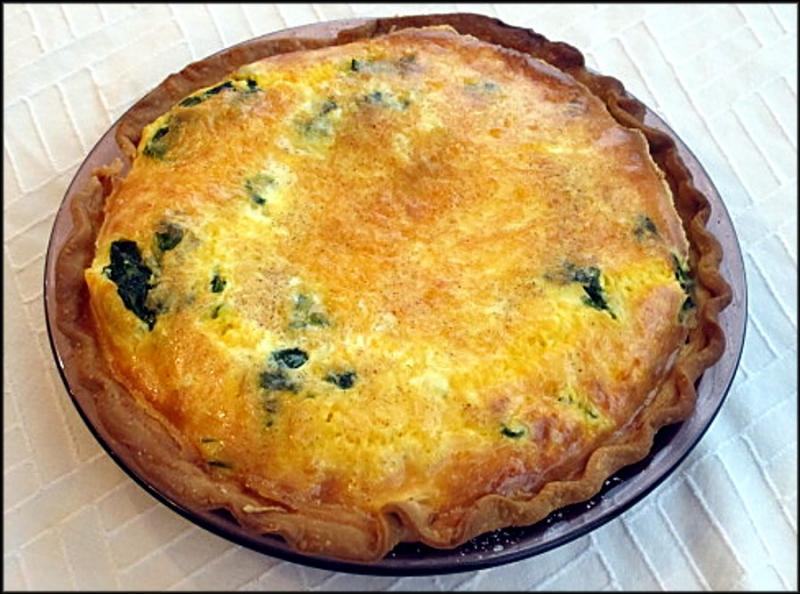With the right touches, quiche can be a hearty meal option
Being trapped inside during Monday’s snowstorm gave me the initiative to begin what my friend Marie calls “pantry reduction,” as in use up all those bags of bits that are filling the refrigerator, freezer and cupboard.
I started with the package of ham, left over from a holiday meal, and after one sniff opted to give it a new home in the trash bin. The cremini mushrooms were in decent shape, so a hearty soup seemed their destination.
I sliced them and tossed them into a saucepan with chopped leek and a knob of butter. Pretty soon, the kitchen smelled like comfort and warmth (if those emotions have an aroma). After I deglazed the pan with vegetable stock, the soup simmered on a back burner for half an hour. By noon, it was ready for a visit from the immersion blender, and lunch was ready.
As I rummaged through the crisper drawers, I found a bunch of scallions that had seen better days and a bag of kale that was almost ready to call it quits. These could become the start of a quiche, as I still had a box of rolled pastry crusts in the refrigerator. In a sauté pan, the vegetables quickly wilted into a buttery mixture while the pie crust pre-baked. I whisked together eggs and cream, and layered the other ingredients with some shredded cheddar.
For many dishes I make, I refer to a recipe to confirm oven temperatures or to check the complete list of ingredients. When I make a quiche, I usually trust my muscle memory to find a workable combination. In the case of the quiche in the photo, I was trying to use up my vegetables and at least some of the half-gallon of light cream the grocery pickup service had substituted for the pint on my list.
Although quiche is usually considered a classic French dish, it actually originated in Germany during the Middle Ages. Its name comes from the town of Lothringen and “kuchen” the German word for “cake,” which evolved into the familiar French dish called quiche Lorraine. The primary ingredients for the traditional version of quiche include eggs, cream, and finely diced ham. In later years, the addition of gruyere cheese became common.
As you may imagine, just like an omelet, a quiche filling can be made with a wide range of vegetables, cheeses and meats, from a slightly lighter-calorie formula to the full-fat version. This is accomplished by varying the liquid (heavy cream versus skim milk) as well as the number of eggs and whether or not to stir in a few extra yolks.
The quiche in the photo was made with four whole eggs, light cream, sautéed scallion, kale and cheddar cheese – all poured into a buttery pastry shell. A few substitutions can remove some of the fat calories. For example, replace the eggs with a mixture of egg whites and whole eggs. Instead of cream, use a combination of half-and-half and low-fat milk. Another option is to use evaporated milk, which is as thick as cream, without all the fat.
Cheese is the trickiest ingredient to safely substitute. Full-fat cheeses that you shred or grate yourself will give your quiche the creamiest consistency and richest flavor. Some varieties of lower-fat, pre-grated cheeses coated in anti-caking ingredients and sold in plastic packages have the tendency to not melt properly and deliver very little flavor. If you elect to forgo the cheese completely, select ingredients with aggressive flavors and some interesting mouthfeel.
One final change to transform your quiche into a low-guilt, low-carb dish is to bake it without a crust. For this type of quiche, the added ingredients are whisked into the custard, not scattered in the bottom of the pie pan before baking. Always give your quiche a few minutes to rest and firm up before slicing, otherwise it will crumble into a pile of scrambled eggs. I’ve included recipes for the quiche in the photo and the traditional favorite, quiche Lorraine.
Kale & Cheddar Quiche
1 pie shell
1 bunch kale
1 bunch scallions
1 T butter
4 eggs
2 C light cream
1/4 t salt
1/4 t white pepper
1 C shredded cheddar cheese
Preheat oven to 350 F. Line a pie pan with pastry dough. Bake for 15 minutes. Remove the kale leaves from the stems and roughly tear into pieces. Thinly slice the scallions. Melt butter in a skillet and add vegetables. Cook over medium until softened, about 4 minutes. In a bowl, whisk together the eggs, cream, salt and pepper. Scatter kale and onion mixture across the bottom of the baked pie shell. Top evenly with cheese. Pour egg mixture into pan. Bake until puffed and golden, about 35 to 40 minutes. Allow to cool before slicing. Yield: 4 to 6 servings.
Quiche Lorraine
1 pastry shell
1 egg
1 T water
4 oz pancetta
3 eggs
1 1/2 C heavy cream
1/2 t salt
1/8 t white pepper
1/8 t grated nutmeg
1/2 C grated gruyere cheese (optional)
Preheat oven to 375 F. Line a pie pan with the pastry shell. Crimp the edges in a decorative pattern and pierce the bottom in a few places with a fork. Whisk together the egg and water; coat the crust with the egg wash using a pastry brush. Bake until set, about 15 minutes; set aside. Cut the pancetta into 1/2-inch pieces. Cook in a large skillet until fat has rendered and meat is lightly browned. Drain on paper towels, then sprinkle pancetta in the bottom of the pre-baked pie shell. Whisk together the remaining ingredients until blended. Pour custard into the pastry shell and place the pan on a baking sheet. Bake until puffed and golden, about 30 minutes. Allow to rest briefly before slicing. Yield: 4 to 6 servings.






















































